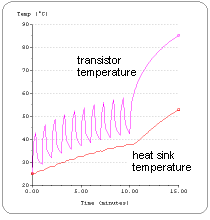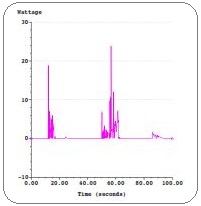|
So what exactly is duty cycle transient?
There are 3 types of thermal modeling calculations:
steady state, simple transient,
and duty cycle transient. Steady state
calculations provide temperature for a unit which is fully warmed up and
has reached equilibrium temperatures. For a simple transient analysis,
an electronic unit is initially at some starting temperature. Power is
turned on and the unit heats up to reach the steady state temperature.
During the simple transient calculation, wattages and ambient temperatures
are held constant.
|
 Duty cycle transient (repeating pattern)
Duty cycle transient (repeating pattern)
 Random power duty cycle
Random power duty cycle
| |
For many real world problems, however, simple transient is just not
enough. Duty cycle transient is required. As an example, think of
antilock brake (ABS) circuitry in an automobile. When the driver of a
car hits the brake pedal, the control circuitry pulses the brakes. This
causes heat dissipation to rise and fall rapidly. To predict temperatures
for an ABS module, wattages must be allowed to vary during the transient
analysis. In other words, duty cycle transient is an absolute necessity.
There are many other real world problems where duty cycle capability is
essential. Frequently, both ambient temperature and heat dissipation
varies with time.
As most engineers know, duty cycle problems vary widely. Some problems
deal with straightforward repeating patterns, such as combinations of
square waves and pulses (see top curve on left). On the other extreme,
as shown in the lower curve, there are "random power" duty cycles.
With random power, the power variation is not easily described and there
are thousands, if not millions, of data points.
Some duty cycle problems have a duration of several hours,
while duty cycles based on millisecond pulses are also common. All in all,
there's a huge variation in duty cycle problems. Nonetheless, Sauna provides
you with the tools to deal with all of these duty cycle configurations.
Defining duty cycles is easy with Sauna
With Sauna, a basic duty cycle problem can be defined in just a
minute or two. To define a square wave, for example, it's a simple
matter of using Sauna's menus to define the first pulse, define the
second pulse, and enter the total number of cycles. Just as soon as
the duty cycle is defined, it can be graphed within Sauna to verify
that no errors were made. It's a simple, no-stress method.
For more complex repeating waveforms, Sauna provides a powerful
scripting language. With just a few lines of script, you can easily
define loops, ramps, and other duty cycle variations (see figures on
right). Even though the scripting language is easily learned,
you can effectively model some very complex configurations.
Finally, there are random power duty cycles. For this case, there
are no repeating patterns. Typically, the time/power characteristics
are measured in the field, or perhaps generated by a simulation
program. To handle these problems, Sauna allows for spreadsheet
definition of power (tab-separated or comma-separated). If required,
you can
have more than one million individual power steps.
Of course,
a large model with a highly complex random power profile can take quite
a while to calculate. Simplification tools are essential.
With Sauna you can easily simplify an entire randorm power profile,
or you can simplify just a portion. With this approach, you can obtain
results in minutes, rather than hours.
Duty cycles can be applied for either wattage or boundary temperature.
There are no limits to the total number of different duty cycles in the
model. It's not even necessary to provide duty cycles which share the
same time coordinates. Sauna automatically interpolates to add the
necessary time coordinates and values. Sauna also incorporates an
integrated standby capability so that a duty cycle problem can be
started with a steady state analysis. Sauna provides a truly
comprehensive set of duty cycle tools.
Calculating temperatures
Temperature calculation is another challenge. After all, no engineer
wants to wait hours for results. Sauna, always known for
rapid calculation times, has a highly advanced temperature solver which
has been specially optimized for duty cycle calculations. For many
problems, the temperature calculation will take just a few minutes. You
should expect that Sauna will be substantially quicker than either FEA
(finite element analysis) or CFD (computational fluid dynamics) software.
As always, Sauna automatically calculates convection and radiation heat
transfer coefficients. Since these heat transfer coefficients are
temperature-dependent, it is important to recalculate these parameters
during the course of a duty cycle analysis. Sauna does this for you,
quickly and efficiently.
Viewing results and modifying the model
Once the temperature calculation is complete, the engineer needs to
review results to identify maximum temperatures. After all, for duty
cycle transient the maximum temperature can occur at any point in the
cycle. To provide a complete view of temperature data, Sauna
incorporates a comprehensive plotting utility. "Temperature vs. time"
data can be plotted on the screen, printed, or exported to other
applications (Postscript, BMP, or spreadsheet format). Temperature
charts can also be prepared. Sauna provides all the tools you need
to interpret and document the results of the duty cycle calculation.
Many times, a duty cycle temperature calculation will indicate that
temperatures are not at acceptable levels. If this is the case,
Sauna has many tools for what-if studies. It's a very simple matter
to modify fins, relocate heat sources, change board copper content
and much more. With all these powerful tools, Sauna is the ideal
tool for duty cycle transient.
|